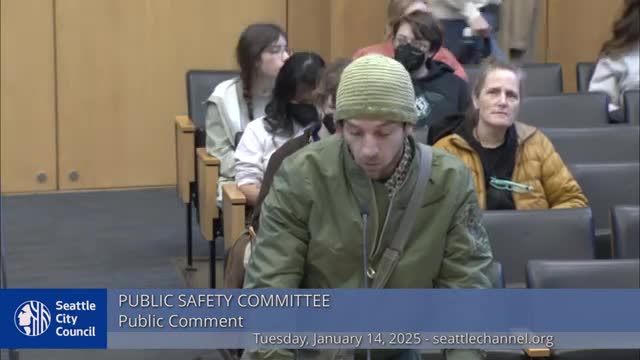Seattle residents protest city council's plan to reinstate controversial police crowd control weapons
January 18, 2025 | Seattle, King County, Washington
This article was created by AI summarizing key points discussed. AI makes mistakes, so for full details and context, please refer to the video of the full meeting. Please report any errors so we can fix them. Report an error »

A powerful wave of public dissent surged through the Seattle City Council's Public Safety Committee meeting on January 18, 2025, as community members voiced their strong opposition to the proposed reinstatement of "less lethal" weapons by the Seattle Police Department (SPD). The meeting, marked by emotional testimonies, highlighted deep concerns over police accountability and public safety.
The discussion was ignited by Sean Isom, a District 1 resident, who criticized the council for prioritizing harmful weapons over the well-being of citizens. "What you're prioritizing now is harmful weapons to a group that has a long history of abusing them on your citizens," he stated, urging the council to reconsider the implications of their decisions. His remarks set the tone for a series of passionate testimonies from residents who shared personal experiences of police violence during protests in 2020.
Greg Daverna followed, pointing out the stark contrast between the SPD's budget—set to increase by $10 million this year—and cuts to essential community services. "We all get to take precious time out of our days to come out here and debate over whether the police can continue to assault the working people of this city," he lamented, emphasizing the growing homelessness crisis and the need for better resource allocation.
As the meeting progressed, speakers like Kat Munson and MJ Jurgensen recounted harrowing experiences of police brutality, including injuries sustained from SPD's use of crowd control measures. Munson argued that the proposed amendments to the ordinance merely provided justifications for the SPD's use of dangerous weapons, while Jurgensen shared a personal account of being injured by a blast ball during a protest.
The overwhelming sentiment among speakers was clear: the community is demanding accountability and a reevaluation of how the SPD engages with protesters. Many expressed fears that the reinstatement of less lethal weapons would lead to a repeat of the violence witnessed in 2020, undermining the right to free speech and peaceful assembly.
As the meeting concluded, the council faced mounting pressure to reconsider the proposed legislation. The voices of the community echoed a collective call for a safer, more equitable approach to public safety—one that prioritizes the needs of the most vulnerable over militarized responses to dissent. The outcome of this meeting could significantly shape the future of policing in Seattle, as residents remain vigilant and engaged in the ongoing dialogue about public safety and civil rights.
The discussion was ignited by Sean Isom, a District 1 resident, who criticized the council for prioritizing harmful weapons over the well-being of citizens. "What you're prioritizing now is harmful weapons to a group that has a long history of abusing them on your citizens," he stated, urging the council to reconsider the implications of their decisions. His remarks set the tone for a series of passionate testimonies from residents who shared personal experiences of police violence during protests in 2020.
Greg Daverna followed, pointing out the stark contrast between the SPD's budget—set to increase by $10 million this year—and cuts to essential community services. "We all get to take precious time out of our days to come out here and debate over whether the police can continue to assault the working people of this city," he lamented, emphasizing the growing homelessness crisis and the need for better resource allocation.
As the meeting progressed, speakers like Kat Munson and MJ Jurgensen recounted harrowing experiences of police brutality, including injuries sustained from SPD's use of crowd control measures. Munson argued that the proposed amendments to the ordinance merely provided justifications for the SPD's use of dangerous weapons, while Jurgensen shared a personal account of being injured by a blast ball during a protest.
The overwhelming sentiment among speakers was clear: the community is demanding accountability and a reevaluation of how the SPD engages with protesters. Many expressed fears that the reinstatement of less lethal weapons would lead to a repeat of the violence witnessed in 2020, undermining the right to free speech and peaceful assembly.
As the meeting concluded, the council faced mounting pressure to reconsider the proposed legislation. The voices of the community echoed a collective call for a safer, more equitable approach to public safety—one that prioritizes the needs of the most vulnerable over militarized responses to dissent. The outcome of this meeting could significantly shape the future of policing in Seattle, as residents remain vigilant and engaged in the ongoing dialogue about public safety and civil rights.
View full meeting
This article is based on a recent meeting—watch the full video and explore the complete transcript for deeper insights into the discussion.
View full meeting
